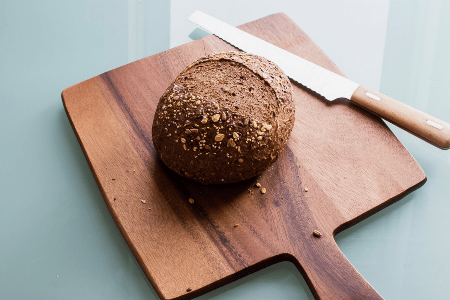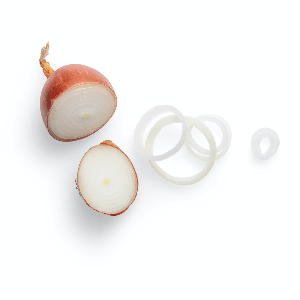Ultimate Cooking Guide by Roger Keyserling (no david read aloud TXT) 📖

- Author: Roger Keyserling
Book online «Ultimate Cooking Guide by Roger Keyserling (no david read aloud TXT) 📖». Author Roger Keyserling

Bread
Many of the bread recipes require just a few simple ingredients, making it easy to get a warm loaf of bread or other treats on the table at a low cost.
A bread machine can complete the full bread-making process, from mixing to kneading, to rising, to baking.
But this awesome appliance can also make a lot more than just loaves of bread, from pizza dough, cinnamon rolls, hamburger and hot dog buns, and even doughnuts.
Some flours that are higher in gluten will help to give you a better rise. Take bread flour, for instance. With a protein content of approximately 14 to 16 percent, the high-gluten flour is your go-to flour for yeast bread, which is the bread that uses yeast as a leavening agent like French bread or sourdough.
Ever wonder what you'd do if there was no bread at the local market? No problem if you have a bread machine! Ingredients for basic white sandwich bread:
1 1/3 cup water
4 tablespoons sugar
2 tablespoons powdered milk
4 1/4 cups AP flour or bread flour
2 1/2 - 3 tablespoons butter
2 1/2 teaspoons bread machine yeast (active dry yeast)
2 teaspoons salt
Salt’s not just important for flavor: it has many chemical interactions with flour and yeast that give good structure and texture to the bread. “Don’t be afraid of salt,”
Know that you can substitute all-purpose flour for bread flour (and vice-versa) using a 1:1 ratio—and if you want to try using bread flour as a substitute for all-purpose flour in recipes for yeast dough that call for all-purpose flour, your bread and pastries will get an extra little lift. Try using bread flour as a substitute for all-purpose bread
Recipe Booklet
Bread is one of the most satisfying bakes you can make in your kitchen. The smell alone is worth the effort. For bakers just starting out, easy bread recipes are the way to go, and in particular quick bread is simple to master.
If your first attempts at baking have landed you loaves that collapse in the machine, don’t get crusty and lack flavor, I wouldn’t blame you for wanting to give up and stock your pantry with loaves from the grocery store as usual.
Dense or heavy bread can be the result of not kneading the dough mix properly –out of many reasons out there. Some of the other potential reasons could be mixing the yeast & salt together or losing your patience while baking or even not creating enough tension in the finished loaf before baking the bread.
Don’t give up yet, though. Baking bread at home is an art and a science, but it’s not magic. We asked a bread-making expert for tips on how to make the perfect loaf at home, and it’s really no harder than confronting your yeast-based fears head-on.

Bread requires very few ingredients, and they’re inexpensive to boot. Most standard recipes include flour, water, yeast and salt, and sometimes a little sugar or oil. If your first loaf doesn’t come out quite right, you can always try again.
After a few goes at making bread recipes, though, you’ll be absolutely hooked on making your own bread and the magic that comes with the process.
How the Bread Machine Makes Bread
Read the recipe. Place the ingredients in the machine according to manufacturers' instructions. Push a couple of buttons.Most machines will:
Warm the ingredients to bring them to an even temperature. Knead twice.* Allow the dough to rise. Mix dough again. Allow rising again. Then bake the dough.*Rapid rise loaves only knead once.

If you want to improve the lifespan of your homemade loaves and keep your homemade bakes fresh for as long as possible, here’s our step-by-step guide on how to store bread maker bread
As soon as you remove your loaf from the pan, place it on a wire rack and allow it to cool completely. If you leave the bread to cool in your bread maker, it will get damp and become soggy.
Once cool, wrap the bread in a zipper-lock plastic bag or in some good quality foil. Most importantly, use a couple of layers to prevent air from getting in and to ensure the bread is wrapped tightly.
Then, store it in a cool, dark place at room temperature in your kitchen for up to 3 days.
If you can, invest in a bread bin or ceramic bead box. This is the best way to keep your loaf fresh for up to 5 days. Just be sure to buy a bin or box that’s well ventilated and always place it away from sunlight.
You could also use a plastic storage container with ventilation holes to allow the bread to breathe and stay moist.
Believe it or not, one of the best ways to store bread machine bread and keep your loaves edible for longer is to store them in the freezer. Simply follow these instructions to enjoy maximum taste and freshness.
Cook your bread maker bread as normal, then take it out of the pan to cool on a wire rack.
Place cooled bread in a storage container or airtight freezer bag and put your loaf in the freezer. Your bread machine bread should keep for up to 3 months.
When you want to use your bread, place it in the refrigerator to thaw overnight. Alternatively, leave it out on the side at room temperature.
If you want your bread to thaw a little quicker, remove it from the freezer bag or container and wrap it in two layers of foil. You can then thaw it in a 250-degree oven for around 30 to 45 minutes. Defrosting it in a microwave oven (minus the foil) will work just as well.
Measuring Exact measuring is very important when using a bread maker. For the most precise measurements, you should use two different types of measuring cups. Liquid measuring cups are usually clear glass or plastic with a spout for ease of pouring.
Measure the liquid ingredient into the cup but do not raise the cup to your eye level to check. Set the cup on the counter and lower yourself to check the liquid level.
Dry measuring cups are usually sold in a nested set that is level across the top of the cup. To measure flour, first, stir the flour to aerate it. Then spoon flour into the measuring cup and using the straight edge of a knife, scrape off the excess. Do not shake the flour to level.
Loaf Sizes One pound, 11⁄2-pound, and 2-pound bread makers do not actually refer to the weight or size of the loaf. These actually refer to the capacity of the bread pan in the bread maker. This bread maker pan has a 2-pound loaf capacity and can also make a 1-pound or 11⁄2-pound loaf.

Yummy Bread Machine Cinnamon Bread
Ingredients
1 cup milk 2 eggs 1/4 cup butter 4 cups bread flour 1/4 cup sugar 1 tsp salt 1 1/2 tsp active dry yeast 1/2 cup packed brown sugar 2 tsp ground cinnamon 2 tablespoons softened butter 2 tsp powdered sugarDirections
Combine the first seven ingredients in the bread machine according to the order manufacturer recommends. (I just dumped mine in, it worked fine.) Set bread machine on the dough cycle. Once the dough is completed, transfer to a floured surface and punch dough down. Let rest for 10 minutes. Divide dough in half and roll into two rectangles that are 9″x14″. Mix together cinnamon and brown sugar. Spread 1 tablespoon softened butter on top of the rectangle, then sprinkle with cinnamon-sugar mixture. Roll dough into loaf starting with short ends and pinch seams closed. Grease 2 loaf pans and place loaves in pans. Cover and let rise another 3o minute until doubled in size. Bake at 350 for 30 minutes. Sprinkle with confectioners sugar and cool slightly before enjoying. Yum!
How To Clean
1. Unplug bread maker and allow it to cool.
2. Remove the bread pan from the oven chamber and remove the bread. Locate the kneading paddle in the bread or remaining on the shaft in the bread pan. NOTE: If the kneading paddle is difficult to remove from the shaft, fill the bread pan with hot, soapy water and let soak for 15 to 30 minutes. Pour the water out. Grasp the kneading paddle and twist back and forth. It should release, then pull off.
3. DO NOT immerse the bread pan in water or place in a dishwasher. Fill the bread pan with hot, soapy water. Wash bread pan and kneading paddle with a soft cloth. Rinse and dry.
NOTE: Do not use abrasive cleaners or steel wool to clean the bread pan. These could damage the non-stick coating.
4. Wipe the outside of the bread maker with a damp cloth. Do not immerse in water or other liquid.

Onion 11⁄2-Pound Loaf
1 cup of water
11⁄8 teaspoons salt
1 tablespoon sugar
3 tablespoons vegetable shortening
2 tablespoons dried minced onion
31⁄2 cups bread flour
2 teaspoons bread machine yeast

IMPORTANT SAFEGUARDS INSTRUCTIONS!
1. Read all instructions before using.
2. Do not touch hot surfaces. Use handles or knobs. Always use potholders or oven mitts to handle hot bread pan or hot bread.
3. Do not put a hand inside the oven chamber after the bread pan is removed. The heating unit will still be hot.
4. To protect against electric shock, do not place cord, plug or appliance in water or other liquid.
5. Close supervision is necessary when any appliance is used by or near children.
6. Unplug from outlet when not in use and before cleaning. Allow cooling before putting on or taking off parts and before cleaning appliances.
7. Avoid contacting moving parts.
8. Do not operate any appliance with a damaged cord or plug or if the appliance malfunctions or has been damaged in any manner. Return appliance for examination, repair, or adjustment.
9. The use of accessory attachments not recommended by the manufacturer may result in fire, electrical shock or personal injury.
10. Do not use outdoors.
11. Do not let cord hand over the edge of the table, counter, surface areas, or touch hot surfaces.
12. Do not place an appliance on or near a hot gas or electrical burner, or in a heated oven.
13. Do not use the appliance for other than intended use.
14. To disconnect, turn any control to OFF, then remove the plug from the wall outlet. Never pull on the cord.
15. Extreme caution must be used when moving appliances during operation.





Comments (0)